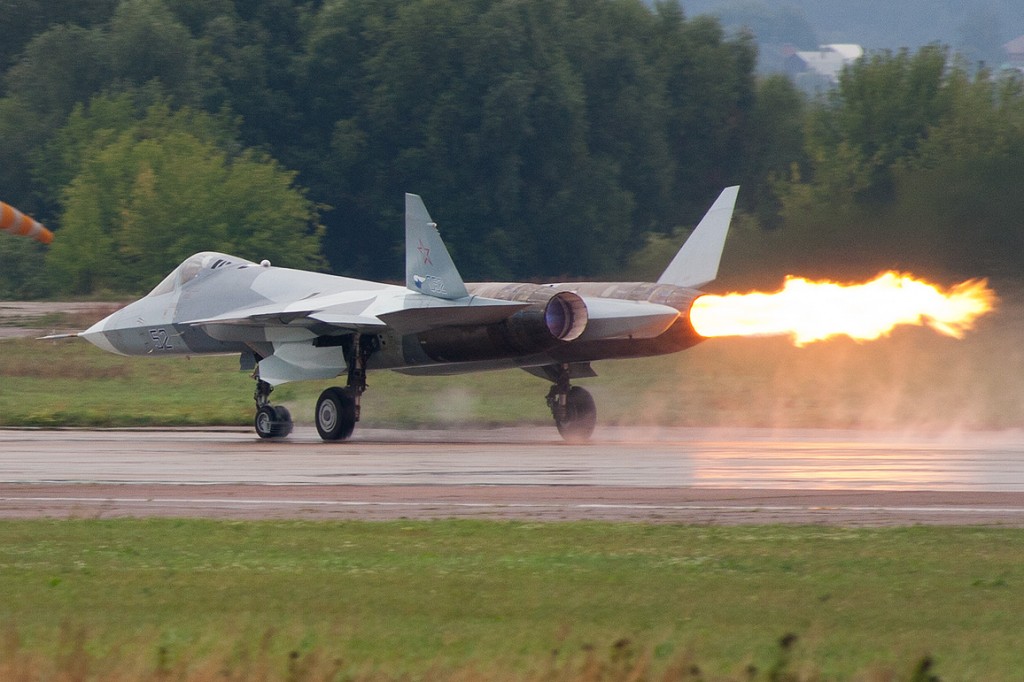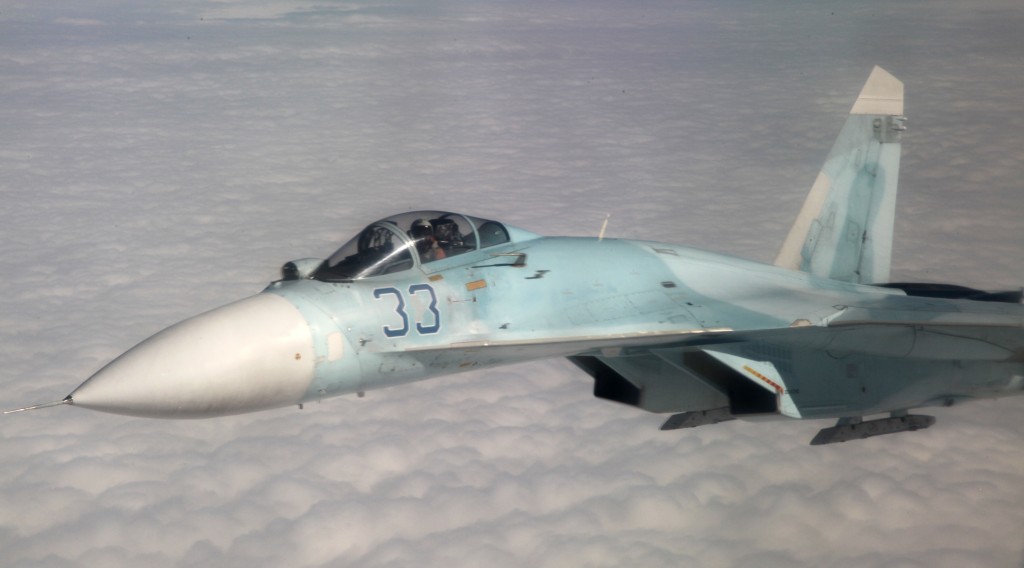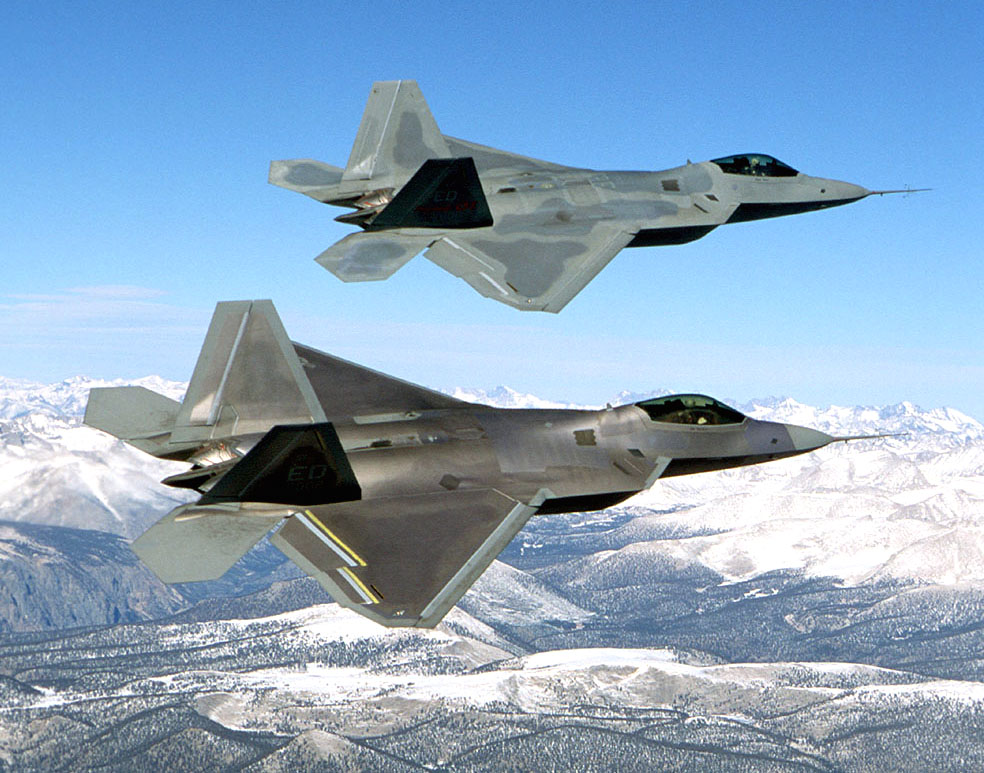On March 3, seven Russian attack planes took off from Novofederovka airbase in Crimea. They flew out over the Black Sea, right toward two North Atlantic Treaty Organization warships, the U.S. guided-missile cruiser Vicksburg and the Turkish frigate Tugutreis.
Russia’s state-owned media described the mission as a reconnaissance exercise. The planes practiced tracking the ships from a distance while staying just outside the range from which the vessels could theoretically shoot back.
This sort of patrol has become ever more common since the war in Ukraine began. Russian aircraft approach NATO vessels or airspace and practice simulated combat maneuvers or engage in reconnaissance. The rate of Russian fighter and bomber patrols near NATO borders has tripled in a year, though it’s still below the weekly flights common during the Cold War.

A Russian T-50 stealth fighter experiences a compressor stall on one of its two engines during a test at the MAKS air show near Moscow in 2011. Rulexip/Wikimedia photo
Worried? To be sure, the Russian air force is formidable. It’s the world’s second largest in terms of combat aircraft, with roughly 2,500 warplanes, of which more than 70 percent are serviceable. Unlike Russia’s navy, which has been essentially reduced to a coastal defense force, its air force is still capable and deadly by global standards. It has the world’s second-largest strategic-bomber force, capable of delivering nuclear weapons thousands of miles from home.
But Russia’s air force has a lot of problems familiar to other branches of the Kremlin’s military. With few exceptions, its aerial fleet dates to the Cold War and is getting older. Modern and capable fighter jets are entering service, but only in small numbers. Over the long term, Russia’s air force is expected to dwindle further.
The roots of these problems date from the collapse of the Soviet Union in 1991. Factories producing aircraft and parts have shut down or became part of foreign, predominantly Ukrainian, territory. Engineers experienced in building jets have immigrated or retired. Moscow put a halt to buying new planes – it bought none until 2003 — and halted most training exercises.
Russia has a lot of catching up to do. The Kremlin now considers modernizing its air force a top priority. This isn’t just acquiring new, modern warplanes but also upgrading existing ones. In 2014, Russia spent more than a billion dollars on newer avionics and electronic warfare systems, which can allow Russian jets to more effectively flood radars and enemy jets with electromagnetic energy.

Russian Air Force Su-34 fighter-bombers take part in a military parade during celebrations marking Independence Day in Minsk, July 3, 2014. REUTERS/Vasily Fedosenko
Altogether, Russia plans to spend $130 billion on modernizing its air force through the rest of the decade, according to research scientist Dmitry Gorenberg’s blog Russian Military Reform.
Russia’s state armament program, which sets out military procurement policies through 2020, heavily emphasizes relying more on domestic manufacturing. “Such an approach is not without its own difficulties,” noted OE Watch, the monthly newsletter of the U.S. Army Foreign Military Studies Office, “which the Kremlin does not publically discuss.”
Among these problems is that Russia’s domestic industry has serious shortcomings when it comes to building microelectronics. These components are less glamorous than airframes and missiles, which Russia builds quite well, but crucial to modern fighters. The technology enables lethal advantages like night vision and thermal imaging systems.
Building up the domestic aviation industry isn’t just a job-creation program. For Moscow, it’s an absolute necessity. A huge amount of Russian military hardware came from Ukraine until the war between the Ukrainian government and pro-Russian separatists put an end to that.
Ukraine’s state-owned military company, Ukroboronprom, for example, produced many of Russia’s helicopter engines until the firm cut ties last year. Russia cannot physically produce enough engines to modernize its helicopter fleet, according to the Royal United Services Institute, a British defense research group, so most of its engines were made in Ukraine.
Russia and Ukraine co-built the An-124 heavy transport plane, which relies on Ukrainian factories for more than half its parts. (Though Moscow’s military transports have considerable lifespans.) One of the largest Ukrainian aviation factories that supplied parts to Russia is in Zaporizhia, close to pro-Russian separatist territory.

A Russian Federation air force Su-27 fighter participates in Vigilant Eagle 13. (Photo by Mary Kavanagh, Canadian Forces Artist Program/Released)
“Many of the auxiliary systems, from hydraulics to drogue parachutes, for the Russian Su-27, Su-30 and Su-35 fighters, as well as for Russia’s newest Su-34, are also produced in Ukraine,” the research group noted.
These four planes are Russia’s most modern operational fighters. They are actually all similar, with slight upgrades to their engines and electronics. Yet two different Russian companies, Irkut and KnAAPO, build the airframes. Which is pretty redundant and inefficient, but for a reason.
The Kremlin has had a hard time finding buyers on the international market for the jets. So having two companies produce them for the domestic market keeps their production lines open.
Russia’s advanced, “fifth-generation” T-50 stealth fighter, which is still in development, is also having problems. The Kremlin doesn’t disclose what is the matter with the jet, a potential rival to the stealthy American F-22 Raptor. But we can glean some information. Russia and India are co-developing a version for the Indian air force, so its generals have had an up-close look at the T-50. They don’t like what they see.
India sunk more than $5 billion into the initial design, which is to be compatible with Indian-made missiles and navigation systems. New Delhi wants to eventually buy 200 of the fighters, and has few other options. In the T-50′s class, the only competitors on the international market are the Chinese J-20 and the U.S. F-35.
But India wants stealth fighters to counter the Chinese jets, and an equivalent number of F-35s would be far too expensive. The Indian air force also has a great deal of experience flying Russian-made planes. If New Delhi wants to compete with China, this means it can either buy huge numbers of less-advanced fighters or stick with the T-50.

Two F-22s during flight testing, the upper one being the first EMD F-22, Raptor 4001, October 14, 2003. Courtesy of U.S. Air Force
Even India’s generals think the T-50 is still too expensive and has too many shoddy parts. The plane’s “engine was unreliable, its radar inadequate, its stealth features badly engineered,” according to India’s Business Standard, which acquired notes from a 2013 meeting of Indian air force officers.
The newspaper didn’t elaborate, but the reference to stealth features could mean poorly constructed sections of the airframe. Russia has produced five T-50 prototypes, and slight differences in construction, such as mismatched angles on the fuselage, can expose its features to radar. The planes also have big, round engines, a no-no when it comes to staying stealthy.
But the T-50 is still a powerful, fast and long-range fighter, and the Kremlin wants to arm it with its modern, long-range Kh-58UShE radar-homing missiles. The U.S. F-22 and F-35 stealth fighters, and their missiles, are comparatively slower, and the missiles have shorter ranges.
Air Power Australia, an aviation think tank, described the T-50 as being able to potentially win a dogfight against America’s latest-generation fighters, such as the troubled F-35.
But even if this is true, Russia will only be able to build the T-50s in small numbers. Moscow wants 60 operational T-50s by 2020, which is optimistic. The first operational fighter was supposed to enter service last year. It didn’t happen. Now the date is 2016, at the earliest.
Sixty deadly stealth fighters might sound like a lot. But the U.S. plans to build 2,400 F-35s during the next two decades, and has already started delivering them. That’s on top of the U.S. Air Force’s 187 operational F-22s already in service.
Which means Russia’s most advanced planes will be heavily outnumbered.
Meanwhile, the rest of the Kremlin’s fleet will just keep getting older.
Please Share and Comment Below...